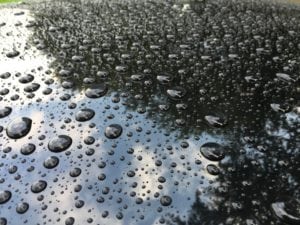 Each house should be reliably protected from atmospheric precipitation. Rain, wind cause a lot of headaches for those who live in this house. To the ceiling is not flooded with water, we must take care of the roof at the design stage and waterproof the roof.
Each house should be reliably protected from atmospheric precipitation. Rain, wind cause a lot of headaches for those who live in this house. To the ceiling is not flooded with water, we must take care of the roof at the design stage and waterproof the roof.
The main impact of the elements on himself takes the roofing: tiles, metal, corrugated board and many other materials. They can not be laid directly on the wooden frame of the roof. Roof waterproofing is necessary.
Condensate from the temperature drop and rainwater that can seep through the cracks, fixing holes can flood the house and destroy the wooden structures. The insulation under the roof locks and will lose its thermal insulation properties. It can not be saturated with water not only from above, but also from below. The rising water vapor of warm living quarters is also dangerous for a heater.
Methods of waterproofing and applied materials
The following materials are used to protect the roof from water and water vapor:
- Rolled reinforced with synthetic thread polyethylene barriers
- Diffusive polyethylene membranes
- Rolled bitumen roofing materials and glassine
- Rolled fusible materials
- Liquid glass
- Bitumen-rubber and polymer mixtures
That the moisture has not spoiled a heater and has not flooded the house to make a steam and waterproofing of a roof.
The diffusion membrane is also suitable. It is made of the same polyethylene but has the smallest pores that let the moisture flow unilaterally. This is very convenient, because the heater can evaporate the moisture that has got into it.
It is important to know! When using a diffusion membrane, it must be laid with the correct side marked on the material. Often this is a red strip, which should look upwards when stacking.
Roll waterproofing rolls across wooden rafters, starting from the bottom of the roof. Mounting is performed with galvanized staples and a construction stapler. The second roll is stacked with an allowance at the first.
After the waterproofing is ready to lay the roofing material. When the exterior works are completed, they pass to the insulation and the fixing of the vapor barrier under the roof. As a heater, mineral or stone wool is often used. It is densely laid between the rafters to their full height.
On top of the rafter stapler fasten rolls of vapor barrier reinforced or diffusion film. To the rafters, the vapor barrier is additionally fixed with counter racks. Now the attic can be sewn with plywood and use it as a living room. It will be warm and dry and cozy.
Important to remember! To know exactly what to choose a roofing waterproofing, you need to read the instruction for the roofing material. It is usually attached to the delivery kit.
For flat roofs, it is recommended to use fusible roofing materials. Before applying such measures of waterproofing, it is necessary to provide for roof slopes in such a way that water does not accumulate on the roof.
The concrete roof is cleaned of debris and dust. Material and concrete are heated with a gas burner and pressed tightly. The surface of the waterproofing is carefully smoothed, removing air bubbles. Subsequent sheets are laid with an overlap on the previous one.
Important to remember! The waterproofing of the flat roof of the annexes by the roll-on deposited material requires special attention in the places of adjoining to the walls.
This is the “Achilles’ heel” for all attached rooms and porches. In this place most often water falls under the layer of waterproofing. To avoid this, you have to do the overtaking on the wall, and above it, you need to install a galvanized ebb. The gap between the ebb and the wall must be treated with silicone sealant for outdoor work.
In the event that a sand-cement screed or concrete is laid on a flat roof, liquid roof waterproofing is applied. To do this, use a liquid glass, which is applied by spraying. Penetrating the pores of concrete or cement base, the solution of sodium silicate tightly clogs them. Such protection is able to withstand rain and snow for 5 years.
Bitumen waterproofing is also used to protect flat roofs. The bitumen is melted and poured onto the screed of the roof. After that, roll it over the surface with rollers. Alternatively, bitumen-polymer mastics can be used. They do not require warming up and are applied with a normal brush.
On how high-quality waterproofing of the roof made by specialists-roofer, depends on the safety of the insulation, and the performance characteristics of the entire roof. At the same time, remember that moisture can come from outside as well as in the form of steam gathering in the under-roof space.
Image credit: Free-Photos
